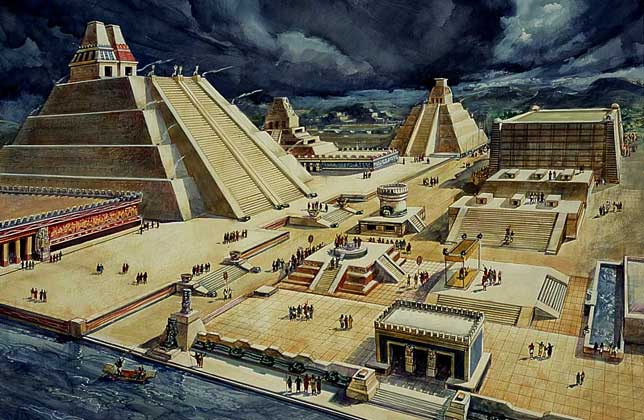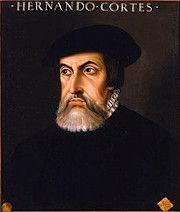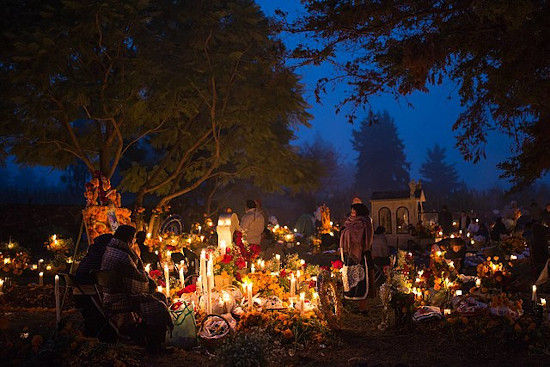History of the Day of the Dead
Some people think that Día de los Muertos, Day of the Dead, is how people from Mexico and Guatemala celebrate Halloween. These two holidays share a few iconic characteristics, such as skeletons and visits from the dead, yet they represent very different cultural traditions.
Halloween’s origins can be traced back to the ancient Celtic festival of Samhain (pronounced sow-in). On October 31 people would light bonfires and wear costumes to scare away dangerous ghosts at a time of year when the veil between the world of the living and the world of spirits was thin and permeable. Día de los Muertos can also be traced back to an ancient tradition, but its origins are rooted in remembrance and love rather than fear.
 Long before North America was colonized—and the land we now call Mexico and Guatemala was exposed to the terrors perpetrated by the Conquistadors—the Aztec people built an empire that covered much of Mexico. Aztec culture was alive with ritual, symbolism, and tradition. One of the most important traditions was to honor the dead. This tradition was so important that the Aztec people spent a whole month every summer in celebrations for and remembrance of the dead. They believed that death was not the end of life, just a transition.
Long before North America was colonized—and the land we now call Mexico and Guatemala was exposed to the terrors perpetrated by the Conquistadors—the Aztec people built an empire that covered much of Mexico. Aztec culture was alive with ritual, symbolism, and tradition. One of the most important traditions was to honor the dead. This tradition was so important that the Aztec people spent a whole month every summer in celebrations for and remembrance of the dead. They believed that death was not the end of life, just a transition.
 In 1519 Hernán Cortés led the Spanish Conquistadors and an alliance of indigenous warriors into Tenochtitlán, the capitol of the Aztec empire and the center of what is now Mexico City. Friendship and cooperation turned to fighting, famine, and a ravaging outbreak of smallpox which gave the Spanish colonizers the opportunity to take power and control over the Aztec people. Over time, the Aztec people adopted many of the Catholic traditions brought to them by the Spanish colonizers. The two cultures influenced one another resulting in some of the rich traditions that are still alive in Mexico and Guatemala today. Día de los Muertos is one such tradition.
In 1519 Hernán Cortés led the Spanish Conquistadors and an alliance of indigenous warriors into Tenochtitlán, the capitol of the Aztec empire and the center of what is now Mexico City. Friendship and cooperation turned to fighting, famine, and a ravaging outbreak of smallpox which gave the Spanish colonizers the opportunity to take power and control over the Aztec people. Over time, the Aztec people adopted many of the Catholic traditions brought to them by the Spanish colonizers. The two cultures influenced one another resulting in some of the rich traditions that are still alive in Mexico and Guatemala today. Día de los Muertos is one such tradition.
 Día de los Muertos is now celebrated on November 1 and 2, known as All Saints Day and All Souls Day in the Catholic calendar. The holiday has evolved into an opportunity to gather with your living family and welcome back your departed loved ones who have passed on to the next world. Symbols like joyful skeletons are a reminder that death is part of life, not its end. Other enduring symbols of Aztec beliefs and traditions that are still central to Día de los Muertos celebrations include skulls, monarch butterflies, and humming birds.
Día de los Muertos is now celebrated on November 1 and 2, known as All Saints Day and All Souls Day in the Catholic calendar. The holiday has evolved into an opportunity to gather with your living family and welcome back your departed loved ones who have passed on to the next world. Symbols like joyful skeletons are a reminder that death is part of life, not its end. Other enduring symbols of Aztec beliefs and traditions that are still central to Día de los Muertos celebrations include skulls, monarch butterflies, and humming birds.
Over the next few weeks we invite you to join us on a journey of discovery and remembrance. You will learn about the symbols, activities, and traditions that make this such a unique and joyful celebration. Check back every week to discover something new and prepare your family for your own Día de los Muertos celebration at home.
Further Exploration
Visit Day of the Dead Resources to find library books for kids and adults, downloadable/printable resources, and additional websites to help you dig deeper into the origins and history of this magical celebration.